The transformation has begun, although it will take time before the small changes accumulate as one significant reform. We will need a lot of patience, but we have a fascinating journey ahead of us.
About Digital Health
Arthur Olesch
June 30, 2022
In healthcare, we have to confront our biggest-ever change, which is digitalization. It requires cultural, organizational, and technological shifts.
And a transformation in the mindset of all stakeholders in the health ecosystem.
How can we lead these changes?
I talked to John P. Kotter, a best-selling author, change management thought leader, business entrepreneur, and Harvard Professor.
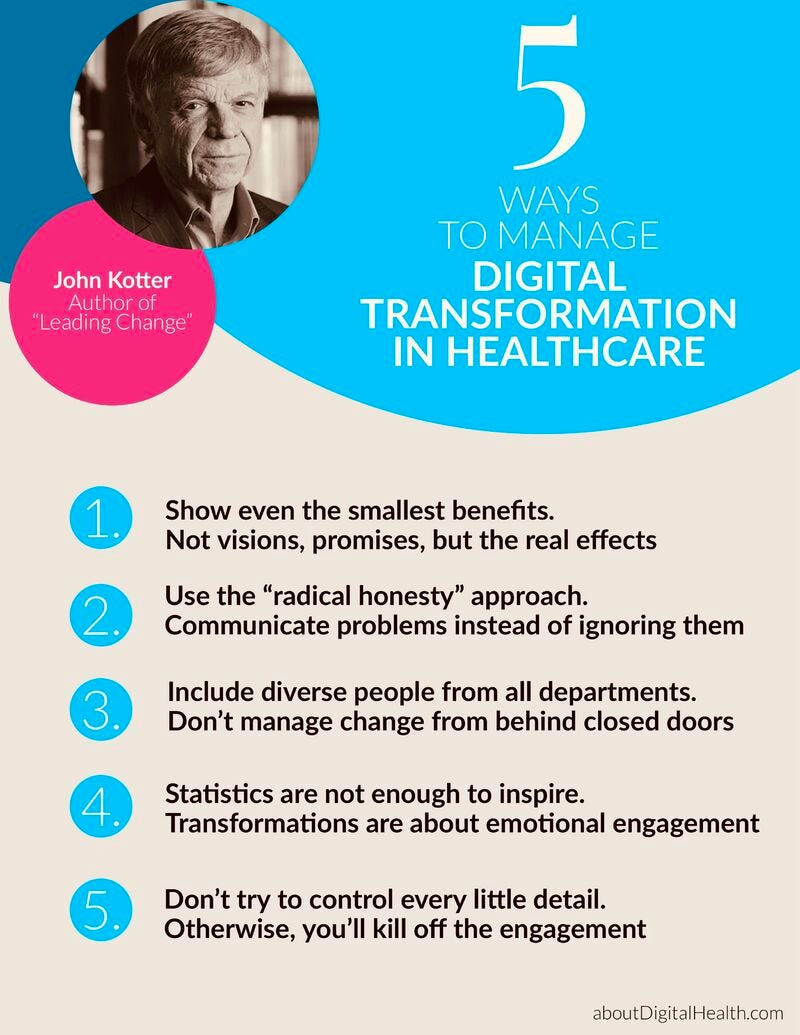
Digitalization in healthcare is not just a change from paper to computer. It’s a change in how people work, communicate with each other, cooperate.
How can we convince people to support digital transformations in healthcare settings, especially since it usually takes years before the first benefits appear?

It’s always important to recognize that you have to produce some immediate benefits.
The benefits do not have to be long-term, global goals.
But there has to be something that people can see and feel, and relate to in a positive way, not just in a neutral, anxious, or angry way.
The more benefits, even small ones, the better.
Nobody is going to be convinced by telling them that something is going to happen ten years from now.
If the time frame is too long, it can lead to an anxiety or anger mode, or passive resistance.
People need facts, need to see that something is moving forward.
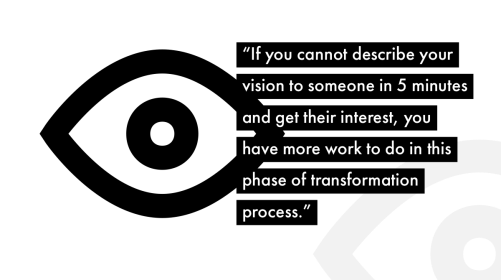
Let’s analyze a typical case study: after an IT system has been implemented in a hospital, the first problems slowly begin to appear.
Doctors get frustrated because they spend more time entering data; the initial enthusiasm slowly fades. What can we do in this case?
It’s crucial to show even the smallest benefits: not words, visions, promises, but the real effects.
A change only works when it’s sincere.
t’s not about PR or thinking in terms of “let’s see how we can advertise the project to make it happen.”
And not even about pushing the changes by saying, “let’s just do it.”
Good managers are honest with themselves, the same as with the rest of the team.
It always depends on the context, the relationship with the doctors and the administration, the internal culture.
Making generalizations is tricky.
One approach that often works, but not always, is something called “radical honesty.”
Don’t try to suppress it or to ignore it, or assume that it’s going to go away after a while.
Instead, you should say, “we are going through what we have heard from others.” Assuming this can be very painful for some.
Spelling out exactly what doctors are feeling, confronting the truth that they are wasting time on paperwork instead of dealing with their patients or focusing on value is the first step. But then you’ve got to start taking action.
And here is where setting the whole transformation upright in the first place becomes essential.
Implementing an IT system in a healthcare setting begins not only with the IT administrators, system consultants, or the management team but with those who genuinely want the change.
Strong leadership and the participation of the most visionary people are critical.
I mean people who see the urgency for the change and think, “we have got to do this, and I am willing to help.”
Putting together a group of such people, from doctors and nurses to administrators, will help you communicate the change, creating more of a positive sense of urgency.
One of the keys we found to successful large-scale changes is to engage diverse people from around the organization, at various levels, in all departments.
Don’t try to create a separate transformation hierarchy.
It needs to be a more network-based process.
The role of the leader is to empower the people, to step forward, and to take the initiative to confront the problem and the barriers, to do something with them, be creative, help out.
I’ve witnessed a situation where, after the failed implementation of a large medical IT system, the CEO of the hospital was fired.
They spent 1.5 billion dollars on software that hadn’t been adapted because people were not convinced, but nobody felt like expressing their negative feelings.
So seemingly everything was fine, but under the surface, there were many hidden, unspoken problems.
Why? Because people weren’t asked for their opinions.
Even when things are going down, and you failed to do the right thing at the prime time, a little radical honesty helps.
It must be followed up by action, such as changes to the system, if required.
Setting up an open and engaging culture for discussing problems helps make more people feel empowered to make suggestions, to take action, to help out.
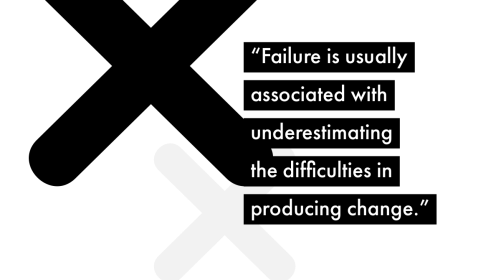
One of the steps in 8-step change management is creating a sense of urgency. If I were a hospital manager, would I ask myself how to formulate this urgency to sound credible?
To sum up, significant change happens in societies, in companies or healthcare.
And they happen because it’s not about a global managed process.
It’s a process where many people are engaged, in any way they can, in their small ways, because they want to.
Anything that doesn’t sound incredible is useless.
It has to be honest, but remember that urgency in the sense I talked about is both an intellectual and an emotional thing.
Could you please mention three do’s and three don’ts that every manager should follow when making changes in an organization?
From one of the projects I was engaged in, I learned that the word “transformation” is useless.
All it did was arouse negative feelings and thoughts. When you’re trying to create a sense of urgency, you do it through experiences, talks, meetings. It is never abstract.
And there is no kind of agenda that I could write down and send out to a thousand organizations, where all they need to do is to adapt it.
Do not try to execute the big change by appointing a small, select group of supposed experts to drive the process.
Just get one thing clear: you’re going to need to win over the hearts and minds of a lot of people. And you don’t want them just not resisting. You want a lot of them helping you.
From the beginning, think in terms of large, diverse groups that need to engage in the game and avoid reducing them to just small, select expert groups.
There’s a lot that can be done in a hospital or any business with small elite expert circles.
But they are never going to make any large-scale transformation.
Another piece of advice: big transformations are like massive, social movements.
People do them because they want to cooperate, and they want to get involved.
They want to help because their hearts are in it, not just their minds.
It’s not only a head game or analytics. You’ve got to win them over emotionally. A good argument and some statistics are simply not enough to inspire.
A third one is that what you ultimately want out of all the people engaged is not just managing the process.
You want them to be proactive. You want them to initiate. You want them to provide leadership in their department or among their colleagues.
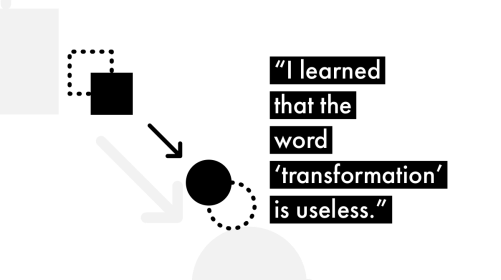
Regarding digitalization in healthcare, what other challenges come to mind, and how can we overcome them?
You can’t manage what you can’t measure and control. And I mean the mindset.
A positive mindset starts with the freedom to take action. Don’t’ be afraid of losing a little control over other people taking steps and initiatives.
Trust can sometimes give your workers and teams the comfort of so-needed autonomy. What you have to do is to light the fire. This is about providing engaging and inspiring leadership.
An executive vice-president of a well-known company recently told me: “You know, I read your books, and think it all makes perfect sense. But in practice, I’m used to managing every little process regularly. If not, I get anxious.”
Don’t try to control every little detail.
Otherwise, you’ll kill off the engagement, you’ll kill off the leadership, and you’ll kill off the transformation.
Well, everybody uses different standards, so when I switch from one doctor to another, and the systems don’t communicate with each other, they are incompatible.
And down here at our place, in Sarasota, Florida, my doctor is old-fashioned.
He has a small practice with three or four offices, and he doesn’t even keep electronic medical records.
For him, as a small business, dealing with people like me who are from all over the country, with no access to information from other care points, it’s not easy.
The interoperability problems are just enormous.
Healthcare in this state is a horror show right now — there aren’t enough established standards in the system.
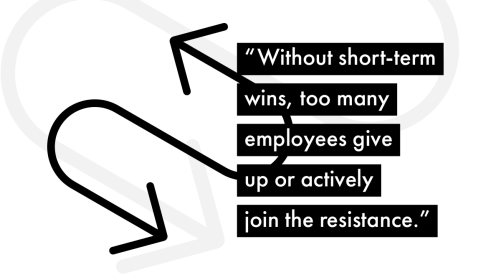
I think another challenge is to move from purely reactive healthcare to more proactive healthcare.
It’s not going to happen anytime soon because everything is built around reactivity, around “you get sick and come to us.”
Even if there are physicians who want to change something, they are stacked in a bigger, static system.
But there are more and more people who see the need for change, so the process has begun.
What’s even more important is that patients start to push this transformation, realizing that the system doesn’t cover their needs.
This inevitable change will also be driven by the whole reimbursement and health insurance system.
The transformation has begun, although it will take time before the small changes accumulate as one significant reform. We will need a lot of patience, but we have a fascinating journey ahead of us.
The transformation has begun, although it will take time before the small changes accumulate as one significant reform. We will need a lot of patience, but we have a fascinating journey ahead of us.
Originally published at http://aboutdigitalhealth.com on February 18, 2020.













